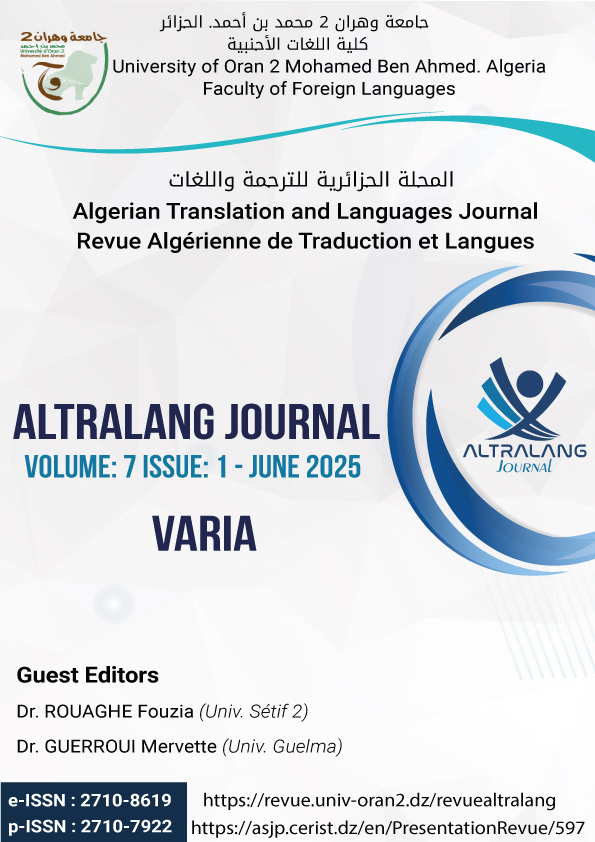Transcreation: Source Content Transition into Another Content Creation via the Source Nucleus and the Target Substitutes
Main Article Content
Abstract
The study aims to demonstrate the source nucleus as the stable element, the source variables as unstable elements and their target substitutes in the process of the transition and the creation of contents via transcreation. Moreover, this investigation addresses the theoretical and the practical-knowledge gaps in transcreation research area; to clarify the understanding of the transition and the creation features within transcreation technique dimensions in translation field, through its practical implications. The study’s methodology attempts to collect existing theoretical records in a coherent layout. It projects them on the two poles of departure and arrival of the content, to connect the dots that draw the bigger picture of the source notion and the target one. Our findings indicate that transcreation application is strongly related to elements of use and/or reference, found in the nucleus from the source and the substitutes from the target that all contribute in the process of the transition and the creation of the content. For practical implications, the research demonstrates transcreation application as another creation of content, built from the change, the creation and the importance of transcreation brief for corporate communication services, in particular. This study is one of the first for its originality. It highlights the combination that builds the transcreated content from the source nucleus and the target substitutes. Moreover, it expands the focus on transcreation theory and practicality that happen to be in line with prior research and applications in the target-focused translations area and beyond.
Article Details

This work is licensed under a Creative Commons Attribution 4.0 International License.
LICENSE: This work is licensed under a Creative Commons CC BY 4.0 license
References
• Belabdi, L. (2024). Is the Leibnizian quote “all change is a kind of transcreation” also valid in translation? Langues & Cultures Journal, 5(01), 10-25. DOI : https://doi.org/10.62339/jlc.v5i01.219
• Bernal-Merino, M. (2006). On the Translation of Video Games. The Journal of Specialised Translation, 6, 22-36. https://jostrans.soap2.ch/issue06/art_bernal.php
• Campos, H. de. (1963). Da Tradução como Criação e como Crítica. Tempo Brasileiro, 4(5).
• Carreira, O. M. (2020). The Transcreation Brief: A Definition Proposal. Transletters: International Journal of Translation and Interpreting, (4), 23-38. https://helvia.uco.es/bitstream/handle/10396/20511/transletters_4_2.pdf?sequence=1&isAllowed=y
• De Bortoli, M. & Maroto, J. (2004). Languages in International Advertising Campaigns: The Transcreator. http://mail.globalpropaganda.com/articles/Trans-creator.pdf
• Di Giovanni, E. (2008). Translations, Transcreations and Transrepresentations of India in the Italian Media. Meta : Journal des Traducteurs/Meta : Translators' Journal, 53(1), 26-43. https://doi.org/10.7202/017972ar https://www.erudit.org/en/journals/meta/1900-v1-n1-meta2114/017972ar.pdf
• Díaz-Millón, M. & Olvera-Lobo, M. D. (2023). Towards a Definition of Transcreation: A Systematic Literature Review. Perspectives, 31(2), 347-364. https://doi.org/10.1080/0907676x.2021.2004177 https://www.tandfonline.com/doi/pdf/10.1080/0907676X.2021.2004177
• Gaballo, V. (2012). Exploring the Boundaries of Transcreation in Specialized Translation. ESP Across Cultures, 9, 95-113. https://edipuglia.it/wp-content/uploads/2020/12/ESP-9.2012.pdf#page=89
• Hall, E. T. (1976). Beyond Culture. New York: Anchor Books. https://monoskop.org/images/6/60/Hall_Edward_T_Beyond_Culture.pdf
• House, J. (2006). Text and Context in Translation. Journal of pragmatics, 38(3), 338-358. https://doi.org/10.1016/j.pragma.2005.06.021 https://www.sciencedirect.com/science/article/abs/pii/S0378216605002109?via%3Dihub
• Jackson, K. D. (2010). Transcriação/Transcreation. In: The Translator as Mediator of Cultures, 3, p.3. Amsterdam: John Benjamin Publishing https://doi.org/10.1075/wlp.3.13jac
• Jimenez-Crespo, M. A. (2024). Transcreation in Translation and the Age of Human-Centred Al: Focusing. New Perspectives in Media Translation: Transcreating in the Digital Age, 309.
• Kress, G. R. & Van Leeuwen. T. (2001). Multimodal Discourse: The Modes and Media of Contemporary Communication. London: Edward Arnold. https://books.google.es/books/about/Multimodal_Discourse.html?id=R494tAEACAAJ&redir_esc=y
• Kress, G., Ogborn, J. & Martins, I. (1998). A Satellite View of Language: Some Lessons from Science Classrooms. Language Awareness, 7(2-3), 69-89. https://doi.org/10.1080/09658419808667102 https://www.tandfonline.com/doi/abs/10.1080/09658419808667102
• Lal, P. (1957/1964). Preface to Shakuntala. Great Sanskrit Plays. In New English Transcreations, 3-10. https://www.google.es/books/edition/Great_Sanskrit_Plays_in_Modern_Translati/RfgbmJ_iLw4C?hl=en&gbpv=0
• Lee, T. K. (2020). Translation and Copyright: Towards a Distributed View of Originality and Authorship. The Translator. 26.3, 241-256. https://doi.org/10.1080/13556509.2020.1836770 https://www.tandfonline.com/doi/pdf/10.1080/13556509.2020.1836770
• Leibniz, G. W. V. (1676). Dialogue Pacidius Philalethes, [Draft] https://www.humanities.mcmaster.ca/~rarthur/phil731/leibnizsdialogue.pdf [Retrieved 22/02/2024]
• Lopes, A. C. (2021). 5 Things to Include in Your Transcreation Brief. Retrieved from: https://www.medmark.pt/post/5-things-to-include-in-your-transcreation-brief
• Munday, J. (2001/2016). Introducing Translation Studies: Theories and Applications. London: Routledge. https://doi.org/10.4324/9781315691862 https://www.taylorfrancis.com/books/mono/10.4324/9780429352461/introducing-translation-studies-jeremy-munday-sara-ramos-pinto-jacob-blakesley
• Newmark, P. (1988). A Textbook of Translation. New York: Prentice Hall. https://www.academia.edu/download/45828515/A_Textbook_of_Translation_by_Peter_Newmark.pdf
• Panou, D. (2013). Equivalence in Translation Theories: A Critical Evaluation. Theory and Practice in Language Studies, Vol. 3, No, 1. Finland: Academy Publisher. https://doi.org/10.4304/tpls.3.1.1-6 https://www.academypublication.com/issues/past/tpls/vol03/01/01.pdf
• Pedersen, D. (2014). Exploring the Concept of Transcreation–transcreation as “More than Translation”. Cultus: The Journal of Intercultural Mediation and Communication, 7, 57-71. https://iris.unipa.it/retrieve/handle/10447/130535/197987/cultus%20_7_2014.pdf#page=57
• Reiß, K. & Vermeer, H. J. (1984). Grundlegung einer allgemeinen Translationstheorie. Tübingen: Niemeyer. https://doi.org/10.1515/9783111351919 https://www.degruyter.com/document/doi/10.1515/9783111351919/html
• Venuti, L. (1995). The Translator's Invisibility: A History of Translation. London and New York: Routledge.
• Vinay, J. P. & Darbelnet, J. (1995). Comparative stylistics of French and English: A methodology for translation (Vol. 11). Amsterdam & Philadelphia: John Benjamins Publishing. https://www.google.es/books/edition/Comparative_Stylistics_of_French_and_Eng/I06D-6gU45sC?hl=en&gbpv=0
• Williams, L. (2024). How to Get the Best Out of Your Transcreator. Mapping Out the Perfect Brief. Retrieved from: https://translatorstudio.co.uk/how-to-get-best-transcreator-and-brief-them/

1.png)